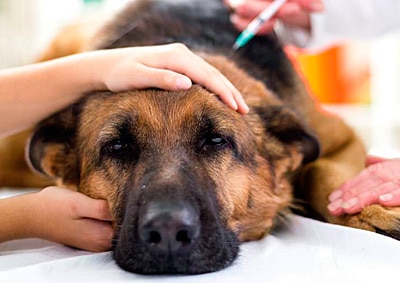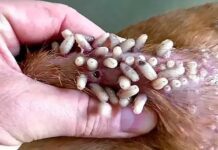Twisted stomach in dogs is a problem that is much more common than you might imagine, so common that it’s possible that your dog will suffer from it at some point. That’s why it’s so important to know what it is, what the symptoms are, and of course, how to prevent it.
It’s an ailment that is very simple to detect, and taking action quickly if your dog has it can save his life. Let’s take a brief look at the characteristics of twisted stomach or gastric volvulus.

What is twisted stomach in dogs?
When a dog’s stomach is full of food or gas, it naturally expands, just like in humans. But in dogs, the stomach is held by two tendons, which sometimes aren’t strong enough to hold it correctly.
When this happens, the dog’s stomach can adopt unnatural positions, becoming twisted in such a way that its contents can’t pass into the intestine or be vomited back up. Likewise, the blood in the stomach also can’t circulate.
This problem can have serious consequences on a dog’s vital organs, even being fatal in many cases. It isn’t a disease; it’s simply a condition that dogs can suffer from.

What are the symptoms of twisted stomach in dogs?
Luckily for us humans, detecting twisted stomach or gastric volvulus is very simple. And if you act quickly, you will greatly increase your dog’s chances of survival. These are the main symptoms that you might notice:
- Excessive panting, nervousness, excessive agitation, anxiety
- Body shaking, abdominal shaking (not to be confused with shivering from cold)
- Attempts at vomiting, excessive saliva, foaming at the mouth, dizziness
- Trouble breathing, inflammation in the stomach area

What to do if my dog has symptoms of twisted stomach?
If you notice one or several of these symptoms of twisted stomach in dogs, you should go to your veterinarian or a veterinary clinic immediately. Time is a fundamental factor that can make the difference between whether your dog lives or dies.
There are no home remedies or anything at all that you can do yourself. You must see a vet, or else your dog will die. There are veterinary clinics that are open (or on-call) 24 hours a day, 365 days a year.
The vet will immediately give your dog an IV to keep him hydrated, will try to pump his stomach or, depending on his condition, begin operating directly. It’s a long operation, and tragically some dogs aren’t able to handle so much time under anesthesia.
If the operation is successful and you follow the guidelines listed below, you can help your dog have a healthy, happy life and return to normal.

How to prevent twisted stomach in dogs
Gastric dilatation volvulus primarily affects large breed dogs, although that doesn’t mean that small breeds can’t get it, too. There are some simple tips that you should follow to keep your dog from getting it.
Truthfully, they are tips that we should all follow, regardless of whether our dog is more or less likely to get twisted stomach, being that it’s common sense advice.
- Wait an hour before feeding your dog if he has been running or doing intense physical activity.
- Wait for your dog to be completely calmed down before feeding him, and avoid giving him food if he’s overly excited.
- Keep him from drinking too much water all at once, for example, if he is very thirsty after getting some exercise with you. Do give him water, but if you see him drinking excessively, take it away and give it to him a little bit at a time.
- Avoid all physical exercise for at least one hour after each meal. The best thing is to have a nap.
- Keep him from eating until he’s stuffed, don’t let him eat excessive amounts of food. It’s much better to divide his food into two, three or four meals per day, for example.
- Although it hasn’t been scientifically proven, some studies suggest that putting his food bowl at a height that is half-way between the floor and his head can help prevent twisted stomach.

Can a dog have a normal life after having twisted stomach?
Of course! Twisted stomach can be fixed with an operation, which, although it is a hard and complex operation, saves the lives of many dogs each year.
Your vet will tell you everything you need to know to keep it from happening again, and it’s even possible that after the operation, you dog will have stronger tendons. But being realistic, there is always a risk that it could happen again, which is why it’s important to follow these guidelines to the letter.
They can lead a normal life, full of playing and petting, just like they always have. You simply have to keep a few things in mind, as we discussed in this article.





